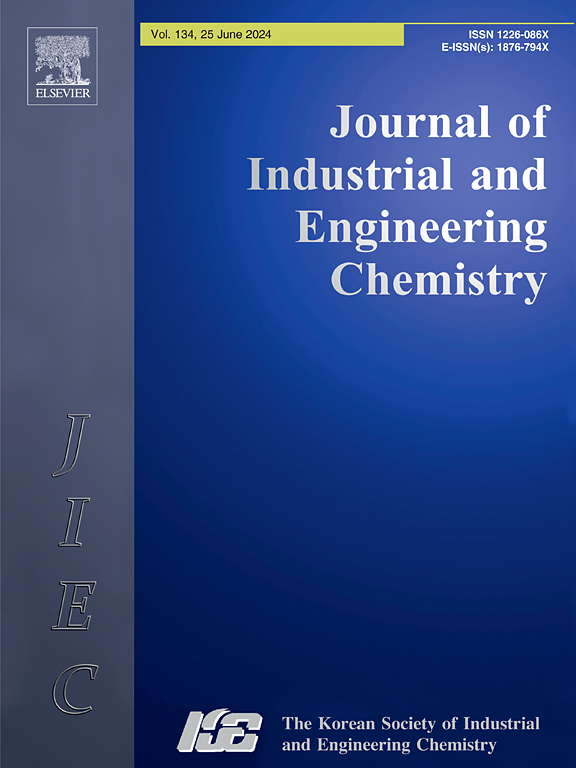Novel α-MnO2/AC catalysts for heterogeneous catalytic ozonation process to remove BAA in dye wastewater
IF 5.9
3区 工程技术
Q1 CHEMISTRY, MULTIDISCIPLINARY
Journal of Industrial and Engineering Chemistry
Pub Date : 2025-01-25
DOI:10.1016/j.jiec.2024.06.044
引用次数: 0
Abstract
Designing catalysts that are both efficient and resistant to interference poses a significant challenge in the field of catalytic ozone oxidation. In this study, four composite nanomaterials with different crystalline phase structures of MnO2 and its loading onto activated carbon were synthesized by hydrothermal synthesis-calcination method and successfully used to catalyze the degradation of BAA by ozonation. The synthesized α-MnO2/AC showed excellent performance and stability, and the degradation rate of 100 mg/L BAA could reach 96.27 % within 40 min under optimal conditions. Compared with MnO2 alone, α-MnO2/AC possessed lower polarization resistance, faster charge transfer rate, and higher Mn3+ and oxygen vacancy contents. Through the mechanistic study of Heterogeneous catalytic ozonation (HCO), it was confirmed that Mn(III) and oxygen vacancies together acted as active sites to enable O3 adsorption and activation to generate ROS, and ![]() OH and 1O2 reacted with BAA as the main ROS in this system. In addition, a potential pathway for the degradation of BAA by HCO was proposed and evaluated for its toxicity. This study provides a new strategy and understanding for designing manganese dioxide composite catalysts with different crystalline phases and the mechanistic exploration of the HCO pathway.
OH and 1O2 reacted with BAA as the main ROS in this system. In addition, a potential pathway for the degradation of BAA by HCO was proposed and evaluated for its toxicity. This study provides a new strategy and understanding for designing manganese dioxide composite catalysts with different crystalline phases and the mechanistic exploration of the HCO pathway.

新型 α-MnO2/AC 催化剂用于异相催化臭氧工艺去除染料废水中的 BAA
设计高效且抗干扰的催化剂是催化臭氧氧化领域的一个重大挑战。本研究采用水热合成-煅烧法合成了4种不同MnO2晶体相结构的复合纳米材料,并将其负载在活性炭上,成功地用于催化臭氧氧化降解BAA。合成的α-MnO2/AC具有良好的性能和稳定性,在最优条件下,对100 mg/L BAA的降解率在40 min内可达96.27%。α-MnO2/AC具有较低的极化电阻、较快的电荷转移速率、较高的Mn3+和氧空位含量。通过多相催化臭氧化(HCO)的机理研究,证实了Mn(III)和氧空位共同作为活性位点,使O3吸附活化生成ROS, OH和1O2作为该体系中主要的ROS与BAA反应。此外,提出了一种HCO降解BAA的潜在途径,并对其毒性进行了评价。本研究为设计不同晶相二氧化锰复合催化剂和探索HCO反应机理提供了新的思路和思路。
本文章由计算机程序翻译,如有差异,请以英文原文为准。
求助全文
约1分钟内获得全文
求助全文
来源期刊
CiteScore
10.40
自引率
6.60%
发文量
639
审稿时长
29 days
期刊介绍:
Journal of Industrial and Engineering Chemistry is published monthly in English by the Korean Society of Industrial and Engineering Chemistry. JIEC brings together multidisciplinary interests in one journal and is to disseminate information on all aspects of research and development in industrial and engineering chemistry. Contributions in the form of research articles, short communications, notes and reviews are considered for publication. The editors welcome original contributions that have not been and are not to be published elsewhere. Instruction to authors and a manuscript submissions form are printed at the end of each issue. Bulk reprints of individual articles can be ordered. This publication is partially supported by Korea Research Foundation and the Korean Federation of Science and Technology Societies.

 求助内容:
求助内容: 应助结果提醒方式:
应助结果提醒方式:


